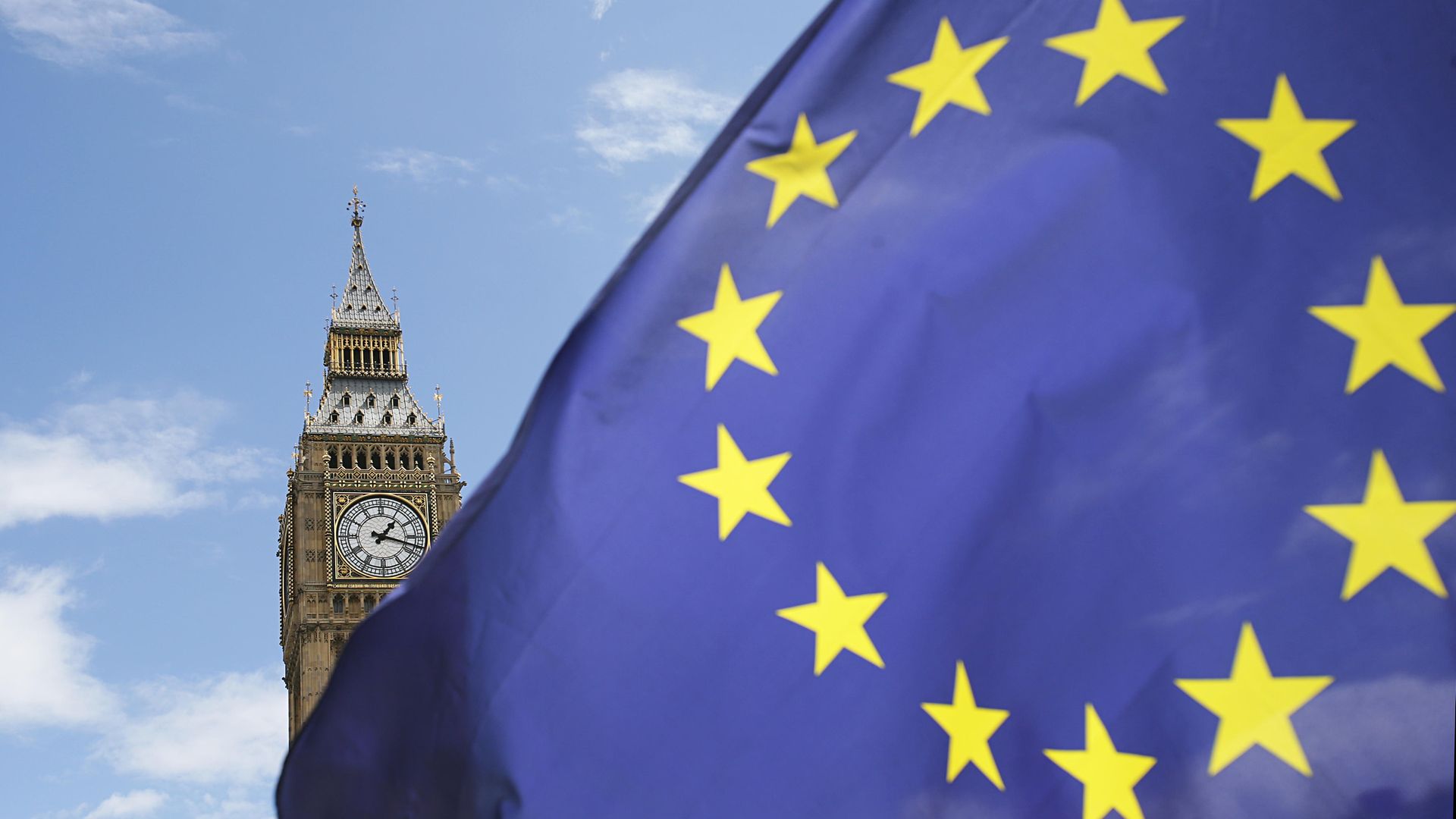
Leading pollster PETER KELLNER on the ways that public opinion on the issue has changed, and what it means for pro-Europeans.
Two big lessons can be learned about public opinion since Britain’s agreement with the EU came into force in January.
The first is that there has been a clear rise in support for Brexit. The second is that, given all that has happened in recent weeks – not least the spat between London and Brussels over the Covid vaccine – the rise is smaller than might have been expected.
A third lesson is not new, but just as important. Between the blocks of enthusiastic pro-Europeans and passionate Brexiters are millions of people whose views are not set in stone. It is in this group where recent changes are to be found. They are the voters who decided the outcome of the 2016 referendum, and who will determine which side secures the majority in years to come.
YouGov has the longest-running tracker series on Brexit. At frequent intervals since the referendum it has asked people whether, in hindsight, Britain was right or wrong to vote to leave the EU. For the first year – until the 2017 election campaign – the figures resembled the referendum result, with almost all the surveys reporting a slight lead for ‘right’ over ‘wrong’.
Then, after a few months of level-pegging, ‘wrong’ inched ahead. As Theresa May’s negotiations ran into trouble, and parliament voted down her plans for Brexit, ‘wrong’ moved into a steady 5-10 point lead. The gap widened to 12% last autumn, when Boris Johnson warned that his talks with the EU might well break down. The deal, on Christmas Eve, narrowed the gap just a little.
The vaccine row then closed it completely. At the start of April, ‘right’ overtook ‘wrong’ by 46-43%. This was the first YouGov poll more than three years giving a pro-Brexit the lead.
Overall, there has been a 7.5% swing since before Christmas from ‘wrong’ (down from 50 to 43%) to ‘right’ (up from 38 to 46%).
The movements have come from both sides of the Brexit divide. Last November just 6% of those who voted Remain in the 2016 referendum had changed their minds and now said Brexit was right. Almost twice as many Leave voters, 11%, regretted the result.
By the start of this month, those figures were reverse. Twelve per cent of Remain voters are converts who now support Brexit, while the number of Leave voters who have changed their minds is down to 7%.
Those changes matter, but should be kept in perspective. For example, in the past year, the number of voters saying Johnson would make the best prime minister has been as low as 26 and as high as 46% – a 20-point range. And in just two months, from early January to early March, YouGov found that the number of people saying the government has been handling the issue of coronavirus well climbed 19 points from 31 to 50%.
Compared with such roller-coaster rides in public opinion, the shifts over Brexit have been little more than a gentle stroll. That said, pro-Europeans should still be cautious. One reason is that other polls have for some weeks pointed to a small pro-Brexit majority.
These polls ask not whether we took the right decision five years ago, but how we would vote today. Deltapoll detected the switch last month, as have three out of four Kantar polls conducted since December. It looks as if a small – but, in a tight race, potentially decisive – group of voters think we made a mistake leaving the EU, but are now reluctant to upset the new status quo by going through the palaver of reapplying for membership.
This reflects a wider point. Millions of voters – something like one-third of the electorate – have mixed or uncertain views about Brexit. Instead of belonging to one of two fiercely solid tribes, for and against, they spread out along a continuum.
Their views about the EU are usually tentative. News about Brexit seldom engages their interest. Passions flare up and die down. One day they will be happy with Brexit, the next day they will regret it. ‘Right-wrong’ and ‘in-out’ polls draw a line at a specific point on the continuum at a particular moment. They are a useful guide to the ebb and flow of the argument, but inevitably simplify the true state of public opinion.
Recently, Opinium has added a fresh dimension by offering not two options but four. It has asked its question twice this year, and obtained similar results both times. The figures from its latest survey are shown in the chart.
In some ways, the news looks good for the European cause. By a clear 18-point margin – 55-37% – voters want Britain to have closer links with Europe. However, when we look separately at each of the four answer options, public opinion is more nuanced. That 53% combined the 31% who want to rejoin the EU with 24% who want to “remain outside the EU but negotiate a closer relationship with them than we have now”. The 37% who are Eurosceptic divide evenly between those who like Brexit as it is and those who would prefer “a more distant relationship than we have now”.
The key group is the 24% who want a closer relationship without rejoining the EU. By adding them to those who want Brexit reversed, we get our pro-European majority. But if we add them instead to the 37% who are plainly Eurosceptic, we reach 61% who don’t want Britain to rejoin the EU. By that reckoning, anti-membership voters outnumber pro-membership voters by two-to-one.
The wisest course is not to put too much weight on any particular number, but to acknowledge that public opinion is seldom as tidy as we might like. But nor should we lurch to the other extreme and ignore polls altogether. Read carefully, they tell us quite a lot.
At the moment, they tell us that neither side in the Brexit debate enjoys unqualified majority support. There has been two-way traffic since the referendum five years ago. One in four Leave voters now want closer links to the EU – and they include 4%, around 700,000 voters, who would now like Britain to rejoin the EU. Against that, 11% of Remain voters, or almost two million of them, now reject closer links with the EU; they include around half a million who would like a more distant relationship.
As for the two main parties, the Conservatives are in a happier place. A big majority of Tory voters support Brexit, although the Opinium survey indicates that almost one in four would like to get closer to the EU in some way.
Keir Starmer has a bigger problem. According to Deltapoll, 72% of Labour voters would vote to rejoin the EU, and YouGov reports that 59% of party members want Starmer to campaign for this outcome. He rejects this view. He is worried that Labour lost all those “red wall” seats to the Tories because many traditional Labour voters in the North and Midlands supported Brexit and blamed Labour’s leadership for being out of touch with their concerns.
Starmer’s task is obviously tricky. However, two points are worth considering. The first is that, as John Curtice has pointed out, Labour voters, even in “red wall” seats, overwhelmingly oppose Brexit. Starmer needs to keep them onside, not just win back the votes he has lost. His calculation seems to be that he need not worry about the pro-EU stance of party voters and members. Come the next election, they have nowhere else to because they are itching to turf Johnson out of Downing Street. Is he wise to make that assumption, if the Liberal Democrats, Greens, SNP and Plaid Cymru all set out clear policies for working more closely with Brussels?
Secondly, Deborah Mattinson’s excellent deep-dive into the mood of voters, in her book Beyond the Red Wall, provides persuasive evidence that Brexit was not the underlying cause of Labour’s defeat. Rather, it was a symbol of long-term problems. In particular, long-term industrial decline, the loss of so many decently-paid manual jobs and the decay of once-thriving town centres, have fed the view that the metropolitan elite is guilty of neglecting the lives of millions of people who, for decades, looked to Labour to help them. Brexit brought all this into focus. The EU looked like a project undertaken by the elite for its own benefit. It was guilty by association.
Today, the consensus among mainstream economists is that Brexit will make Britain poorer – and the ex-industrial “red wall” areas will suffer most of all. If Labour is to win back the seats it has lost, it needs a viable strategy for reviving not just the national economy but the prospects for those areas. This implies a plan to restore at least some of the UK-EU links that Brexit has severed.
That is why the results of the four-way Opinium question are so significant. The swing group comprises the 24% who want a closer relationship with the EU but don’t (yet?) want Brexit reversed. If we assume that rejoining the EU is a long-term ambition, unlikely to be offered at the next election as an immediate objective, then votes can be won by a campaign that combines a new deal with the EU to the specific needs of the voters that Labour needs to win back.
If Johnson, leading a more-or-less unified party on this issue, can persuade voters that Brexit is going well, he will be hard to defeat at the next election. Wherever Labour ends up, its first task is to undermine that Panglossian sentiment. A bold and compelling alternative to the current version of Brexit would help. Starmer’s task is not easy. Serious politics never is.










